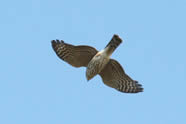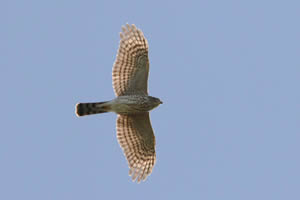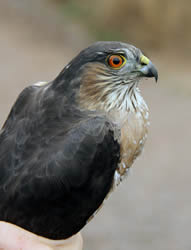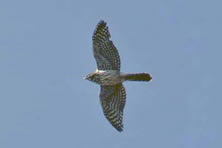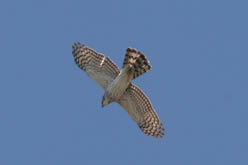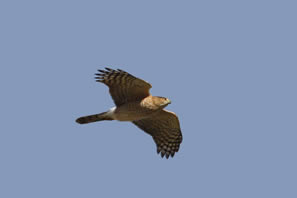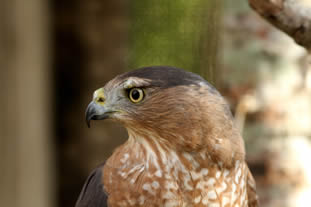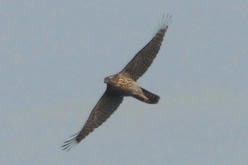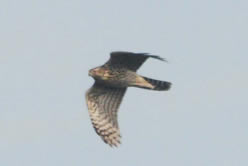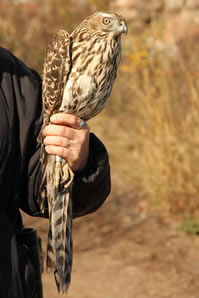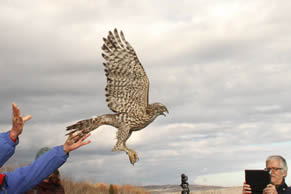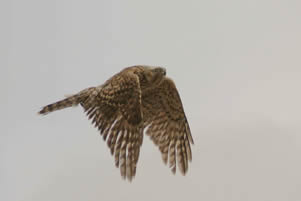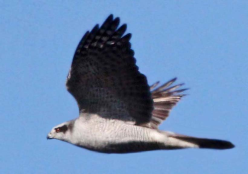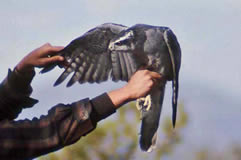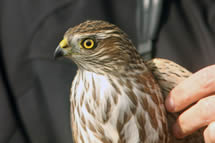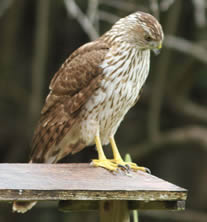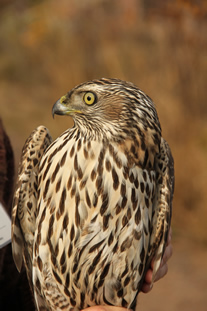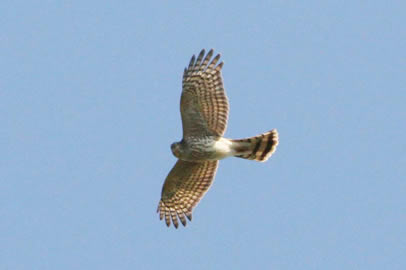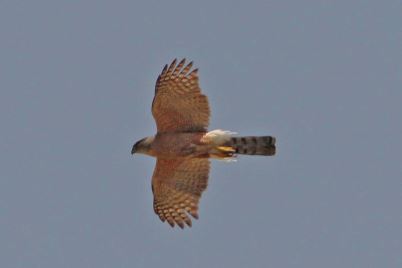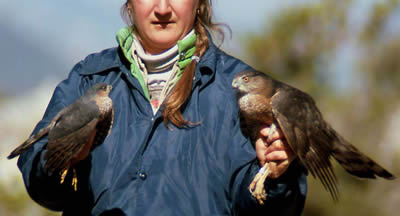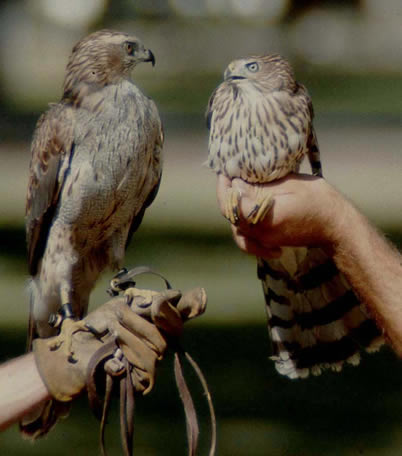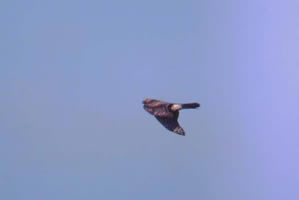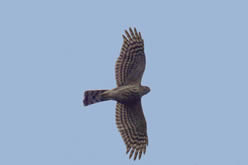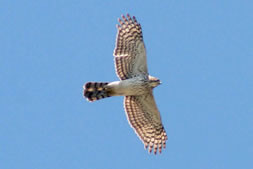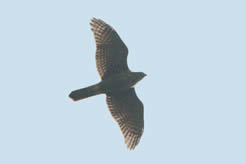IDENTIFICATION PRIMER: Accipiters
It’s late fall; maybe winter. You’re birding your favorite local suburban park. Suddenly, a fairly large brownish hawk explodes from the woods and skirts the tree line. After a rock-steady glide and a few quick wing-beats, it darts back in and is gone. It had broad, rounded wings and a very long tail. It seemed larger than the Cooper’s Hawks you’re used to. Plus you definitely saw a white line above the eye and a lot of white in the lower belly/under-tail area. Was this a Northern Goshawk?
Click on any image for full-size view.
This type of sighting—and accompanying identification happens in the Carolinas almost every year. However, the bird I just described was NOT a Goshawk; it was an immature female Cooper’s.
The above description includes some of the most common identification misassumptions regarding the identification of large Accipiters. This primer will describe—and contrast the actual and salient field marks usable for identifying all three species which occur in the Carolinas.
General: All Accipiters are forest-dwelling hawks that hunt by a close-quarters ambush, dash and catch strategy. Their long tails and relatively short broad wings facilitate this lifestyle. Females average a third larger than males. In North America, there are three species: Sharp-shinned Hawk (“Sharpie”), Cooper’s Hawk, and Northern Goshawk. First year birds are brown with streaked/spotted under-parts. Adult plumage, acquired (mostly) after the first spring molt, combines gray-brown to blue-gray upper-parts with brick red (Sharp-shinned and Cooper’s) or silver-gray (Goshawk) under-parts.
Sharp-shinned Hawk. Smallest of the group, this species is comparable in size to a Blue Jay. The wings are broad and rounded, and show a distinct “hand” formed by elongated outer primaries. The tail is long although proportionally the shortest of the group. The tail tip is generally squared but varies from slightly notched (males) to slightly rounded (females). The head is relatively short; not projecting past bend of wrist in birds with slightly flexed wings. [Figure 1].
Immature Plumage: The under-parts are marked by long, vertical streaks, often with a slight reddish-brown hue. The streaking is heaviest on the upper chest but typically extends to include the belly and flanks. By comparison, Cooper’s Hawks have mostly or entirely unmarked white bellies and flanks. The tail bands, excluding the outermost tail feathers, are blackish and straight across (not wavy). [Figure 2].
Adult Plumage: The upper-parts vary from grayish-brown (females) to blue-gray (males). The under-parts are finely barred with brick red on white. The crown is blackish, being more distinct and contrasting in males. From below, the tail bands (excluding outermost) are black and straight across. Over the first few years, the eye color changes from yellow to orange to red. [Figure 3].
Cooper’s Hawk. This medium-to-large species is comparable in size to a Crow although the body weight is less. The wings are short and broad, often with a bluntly pointed wing-tip. Proportionally Cooper’s hawks appear as the shortest-winged and longest-tailed Accipiter species, even though a Goshawk’s tail is proportionally longer. In flight the head protrudes noticeably farther than with a Sharpie. The tail of a Cooper’s Hawk is distinctly longer than that of a sharpie and has a noticeably rounded tip [Figure 4] although this is not infallible.
Immature plumage: The under-part streaking is commonly limited to the chest and upper belly leaving the mid-belly, flanks and under-tail coverts white; often starkly. Many birds exhibit a bold white eye-stripe which occasionally may be more prominent than in Northern Goshawk. The under-tail pattern, like Sharp-shinned, is banded with black, straight bars except not on the outermost tail feathers and usually shows a broad white tip. [Figure 5]. This is distinct from that of a Goshawk whose under-tail barring is brownish and wavy (“W”-shaped).
Adult plumage is very similar to adult Sharp-shinned in pattern and progression. [Figures 6 & 7].
Northern Goshawk. This is a large bird, comparable in size to Red-shouldered or even a Red-tailed Hawk. The wings are surprisingly long and tapered; looking more Buteo- or even falcon-like than the “classic Accipiter.” The tail is long and broad, generally appearing as a continuation of the body without marked narrowing. It has a wedge-shaped tip. [Figure 8]. In gliding flight, a Goshawk may flex its wings slightly and resemble a blunt anchor. [Figure 9].
Immature plumage: The under-parts are uniformly spotted and streaked extending to the flanks and under-tail coverts. Essentially, it is the most heavily marked and overall the darkest beneath of the three species. [Figures 10 & 11]. There is a prominent white eye-stripe but this alone is NOT diagnostic with immature plumaged birds because all three species may show this feature. The wedge-tipped tail has a buffy (not white) terminal band. The under-tail bands (all feathers) are brownish, not black, and wavy (“W”-shaped). [Figure 12].
Adult plumage: Unmistakable. The blue-gray back and mantle, contrast with dark brown flight feathers. The black crown and cheek patch are divided by a bold white eye-stripe. More than the mere presence of a white stripe, it is this combination of black and white which is diagnostic. The under-parts are silvery gray with a fine vermiculated pattern of delicate cross-bars on the chest and belly feathers. [Figure 13]. The under-tail are coverts pure white and the under-tail, when closed, commonly shows NO visible banding. [Figure 14]. When fanned, the blackish tail bands on inner tail feathers are wavy (“W” shaped).
Common Identification Pitfalls:
- A white eye-stripe with immature plumaged birds does NOT automatically mean Northern Goshawk. [Figures 15, 16, 17].
- Tail tip shape: Classically, Sharpie has squared tail tip, Cooper’s rounded and Goshawk, wedge. BUT, this is not infallible. Female Sharpies commonly show moderate rounding to the tail, especially if slightly fanned [Figure 18] and a Cooper’s Hawk in molt can show very a squared or even notched tail [Figure 19]. Though as reliable, the wedge-shaped tail of a Northern Goshawk is not commonly touted as a field mark.
- White under-tail coverts: In adult plumage all three species have white under-tail coverts although Goshawk is famous for it. But, with immature plumaged birds, Cooper’s Hawk is the whitest – having not only white flanks and belly, but unmarked white under-tail coverts [Figure 5]. Conversely, Northern Goshawk is the darkest below of the three with large tear-drop shaped spots that are uniformly distributed on the under-parts [Figure 17] to and including the under-tail coverts.
- Size: Judging size in the field is tricky at best and with the extreme sexual dimorphism exhibited by Accipiters, considerable overlap in apparent body/tail length exists. [Figures 20, 21]. Better than judging size (head-to-tail length); a better method is judging relative wing length and overall proportion. Compared with Sharpie, the wings of Cooper’s hawk are proportionally shorter and lack a distinct “hand” formed by slightly elongated outer primaries in Sharpies. Conversely, the wing of a Goshawk is decidedly long and tapered – being for more comparable in shape to that of a Red-shouldered Hawk though proportionally longer and narrower than that species. Thus, with most Accipiter quandaries (meaning Sharp-shinned vs. Cooper’s), Cooper’s will be shorter-winged, longer-tailed and bigger-headed than Sharp-shinned. With “big” Accipiters (meaning Cooper’s vs. Goshawk), a “classic” Accipiter profile (short, rounded wings, long tail, etc.) will indicate Cooper’s Hawk. A bona fide Goshawk will look long winged and long but wide tailed.
Advanced ID tips:
Veteran hawk-watchers commonly judge flap rate and other behavioral attributes of these species for making their identification.
Sharpies have a light, quick flap which includes a considerable arc from top to bottom. The flapping commonly seems rushed and inefficient – as though the bird is flailing at the air with a “butterfly” or “swallow-like” rhythm. Their heads are relatively short and do not project past the bend in the wrist when the wings are slightly flexed.
Cooper’s have a quick but powerful wing-beat. Larger birds with proportionally shorter wings, their wing loading is far greater than that of a Sharpie so the flight reflects that the wings are carrying a much heavier load. They have long, protruding heads that are far more noticeable than with Sharpies. Behaviorally, Cooper’s Hawks (like Northern Goshawks) – when soaring, sometimes raise their heads above the horizontal, seemingly to arch their backs as though to look over the top of a fence. Owing to their proportionally large head and neck, this behavior is far more noticeable than Sharp-shinned. [Figure 22].
Goshawks are powerful fast-flying birds with much slower and shallower wing-beats compared with the other two – at times the flaps have a rowing action. In the air, the birds may look like flying anchors –somewhat comparable to a falcon though the wings are clearly broader and more rounded than any falcon we’d likely see in the Carolinas. Basically, if the bird looks like a “typical” Accipiter, it’s probably NOT a Northern Goshawk.
In summary, Accipiter identification can be tricky – especially when one gets less than a perfect look or absent the opportunity for direct comparison. Learn the relative shape proportions [Figures 23, 24, 25], don’t put too much emphasis on the “classic field guide” attributes and don’t be afraid to admit that some sightings may not be identifiable.


